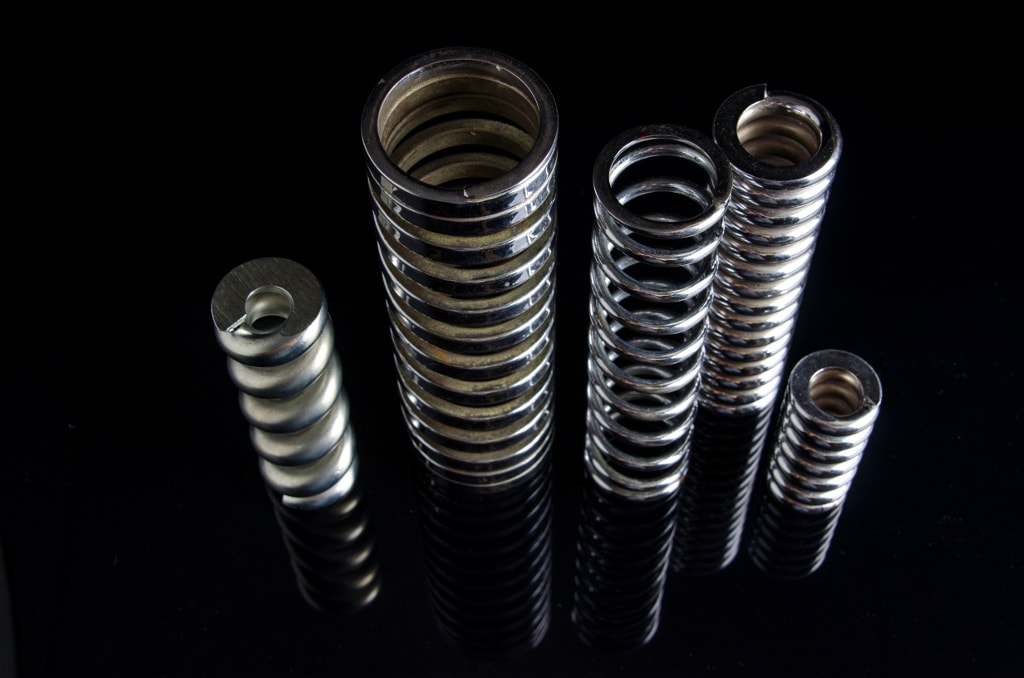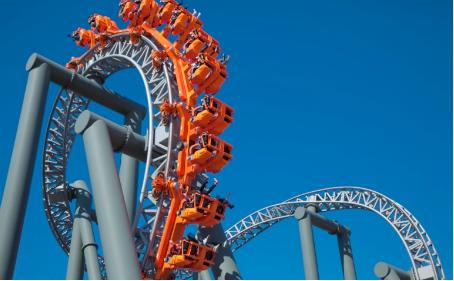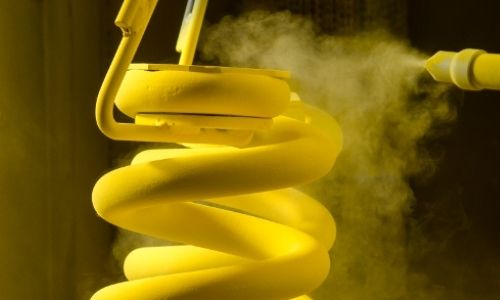Springs serve as an energy storage mechanism and force transmission in various industrial applications. They are utilized in several types of machinery and systems for shock absorption, noise reduction, and motion control. In particular, compression springs are specifically intended to be compressed between two objects to store energy and exert a force.
For over 50 years, Draco Spring Mfg. has designed and constructed high-quality springs, wire forms, and stampings! Currently, we serve over 100 markets, including NASA and aerospace, oil and gas, mining, stock cars and many others.
What Are Compression Springs?
Compression springs are helix-shaped mechanical components that work by compressing or squeezing under an applied load and releasing energy when removed. In other words, the potential energy held in these springs is transformed into kinetic energy as they return to their uncompressed state. This exerts an inward pull on the objects they are utilized with.
The spring rate or stiffness is typically determined by the wire diameter, overall length, and the number of coils. Therefore, the proper selection of spring products should depend on the application’s specific requirements. The following are the common uses of these springs in multiple industries:
- Aerospace components (landing gear, flight controls, and actuators)
- Automotive parts (suspension systems, clutches, brakes, and gear shift)
- Consumer goods (washing machines and refrigerators)
- Industrial machinery (presses, lathes, conveyor systems, CNC machines, and assembly machines)
- Medical devices (surgical instruments, dental tools, and orthopedic devices)
- Oil and gas (valve and pump systems)
Types of Compression Springs
Compression springs are available in multiple shapes, sizes, and configurations to meet the requirements of different applications. Here are five of the most common types:

CONVEX SPRINGS
Convex springs are a type of compression spring that has an outward bulging or dome shape. This shape allows them to store energy, making them a good choice for applications requiring high force. They are commonly used in medical equipment, electrical switches, precision instruments, and other systems where space is limited.
CONCAVE SPRINGS
Also called hourglass springs, concave springs have a shape that narrows in the middle, then widens towards the ends. They are used in applications requiring tight tolerances, as the inward curvature helps limit the variance in the spring’s deflection.
CONICAL SPRINGS
Conical springs — also known as tapered springs — have a cone-shaped design, with the diameter gradually increasing from one end to the other. This design allows the springs to store energy and apply a compressive force when pressed. Common applications for this type include automotive and aerospace engineering, industrial machinery, and household appliances.
VARIABLE PITCH SPRINGS
Variable pitch springs have a varying distance or pitch between the coils. This variation offers a non-linear force-deflection characteristic, meaning that the spring’s force changes as it compresses or extends. Consequently, they are often used in applications requiring a non-linear force-deflection characteristic, such as shock absorbers, clutches, and suspension systems.
VOLUTE SPRINGS
Volute springs have a spiral shape that resembles a scroll. The form is created by winding the coils around a central axis, with the outer rings having a larger diameter than the inner coils. These springs are often used in pumps, compressors, and valves.Compression Spring Design and Specifications
The design and specifications of compression springs must be carefully considered to ensure that they are manufactured to meet the application's requirements. This involves assessing the spring geometry, material selection, spring rate, load capacity, and stress analysis.
- SPRING GEOMETRY
Spring geometry refers to the physical characteristics and dimensions of a compression spring. This encompasses the following attributes:
- Wire Diameter: This determines the spring’s stiffness and resistance to buckling or bending. Thicker wires create a stronger spring, while thinner wires produce a more flexible spring.
- Outer Diameter: This is the distance across the spring at its widest point, perpendicular to its axis. Large outer diameters allow springs to store more energy, whereas small outer diameters result in more compact components.
- Total Coil: This is the total number of turns or loops in the spring from one end to the other. This number also includes both the active and inactive coils.
- Solid Height: This is the length of the spring when it is fully uncompressed and at its maximum height.
- Free Length: The spring’s free length is when it is not loaded or under any compression force. This can be calculated based on the wire diameter, outer diameter, total coils, and solid height.
- MATERIAL SELECTION
The material used to manufacture a compression spring will affect its performance, reliability, and quality. It should be selected based on its properties, operating temperature, environmental corrosivity, and the need for electrical or thermal conductivity. Here are some of the most common materials:
- Carbon steel
- Copper-based alloys
- Hard-drawn wire
- Music wire
- Oil-tempered wire
- Stainless steel
- SPRING RATE
Also known as the spring constant, the spring rate measures the force required to compress a spring by a specified quantity. It is crucial to the design of compression springs and can be used to estimate the spring’s behavior under load.
The spring rate is expressed as a force per unit length of compression and is noted in pounds per inch (lb/in) or Newtons per millimeter (N/mm). It is computed by dividing the change in force by the change in length and is dependent on the material, wire diameter, and total coils.
- LOAD CAPACITY
The load capacity of a compression spring is the highest force or weight it can support without irreversible distortion or breakdown. It is specified in pounds (lb) or Newtons (N). Moreover, it is essential to note that the load capacity should not be exceeded, as it can result in component damage.
- STRESS ANALYSIS
Stress analysis involves the evaluation of the stresses and strains that occur within the spring during operation. It is typically performed using computer simulations and finite element analysis (FEA) techniques. These simulations represent the behavior of the spring under different loads and circumstances, allowing engineers to anticipate the tensions that occur within it.
Other Types of Springs and Their Applications
Spring products are available in various sizes, forms, and materials, each with distinct properties and purposes. They can also provide mechanical energy and support in multiple industries, including automotive, aerospace engineering, and industrial machinery. Examples of spring products and their applications are as follows:
- Belleville Washers: These washers are conical springs that apply or maintain a load in a bolted joint. They are particularly suitable in aerospace, automotive, and industrial applications.
- Extension Springs: These products are similar to tension springs but are stretched rather than compressed. They are often used in garage door openers, trampolines, and tension devices.
- Leaf Springs: These components are flat and curved. They are commonly used in vehicle suspension systems because they absorb shock and maintain stability during driving.
- Tension Springs: These springs store energy and release it as a pulling force. They are often applied to lifting systems, door hinges, and retractable pens.
- Torsion Springs: These springs store energy and release it as a rotational force. Some of its applications include screen doors, clothespins, and mouse traps.
- Wave Springs: These products are disc-shaped, which provide compact and efficient force in limited spaces. They are common in valve systems and pumps.
High-Quality Spring Products From Draco Spring Mfg.
At Draco Spring Mfg., our commitment to excellence is reflected in our use of cutting-edge technology and equipment! We also take pride in our ability to fulfill every spring specification by offering custom design and manufacturing services to suit each customer's unique requirements.
Our experienced engineering team provides skilled technical support to guarantee that our spring products fulfill our rigorous quality and performance criteria. From various types of springs to an array of metal forms, Draco Spring Mfg. has them all!
Contact us today to learn more about our products and services!
High-Quality Spring Products From Draco Spring Mfg.
At Draco Spring Mfg., our commitment to excellence is reflected in our use of cutting-edge technology and equipment! We also take pride in our ability to fulfill every spring specification by offering custom design and manufacturing services to suit each customer's unique requirements. Our experienced engineering team provides skilled technical support to guarantee that our spring products fulfill our rigorous quality and performance criteria. From various types of springs to an array of metal forms, Draco Spring Mfg. has them all!
Contact us today to learn more about our products and services!